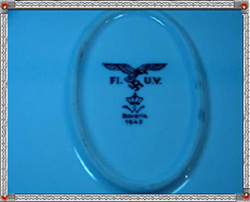
Third Reich porcelain is a difficult subject. The information concerning it is confusing and conflicting. What information there is, that is. In trying to research china my grandfather had brought back from the war in Germany, I became very disheartened at the dearth of information available. Furthermore, what information there is, is a great deal of misinformation!
The Third Reich porcelain reference books I have purchased thus far contain very little or no information about the china I collect Fine Bohemian China supposedly manufactured by Bohemia Ceramic Works. There is more about these books on the literature page. Because you reading this amateur collector's Web site for information, you know how little information there is on the Internet on the subject.
The Third Reich porcelain reference books I have purchased thus far contain very little or no information about the china I collect Fine Bohemian China supposedly manufactured by Bohemia Ceramic Works. There is more about these books on the literature page. Because you reading this amateur collector's Web site for information, you know how little information there is on the Internet on the subject.

Click for more information
The terms porcelain and china are interchangeable. Generally speaking, china usually is used in reference to dinnerware. Porcelain, or china, is a type of pottery. It was invented in China about 200 CE. It is the most complex type of pottery to manufacture. Porcelain is smooth, vitreous (nonporous), thin-walled, and translucent.The European pottery trade business was done mostly in the German language. When reading reference material on the subject much of the information uses German words, and the German names for villages and towns. Bohemia is the German word for Ceský (Czech).
Porcelain manufacturing did not come to Europe until the 1600's when the French mixed clay and ground-glass and baked it at 1100 degrees Celsius. This is not true porcelain; it is too soft. It is referred to as soft paste porcelain.
1707 at the Meissen factory in Saxony, Johann Friedrich Bottger created the first hard past porcelain outside of China. Vienna, Austria soon followed. More about early European porcelain development.
In 1792 the first Bohemian factory was established, but did not commercially produce porcelain for about twenty years. It is a long story that I will try to write about another time. Bohemian porcelain is made from fine-grained white clay (kaolin), feldspar, and quartz and baked at 1400 to 1600 degrees Celsius.
At the beginning of the 1800's Josiah Spode the Second an English person developed porcelain made with fine-grained white clay (kaolin), feldspar, and calcined bone (bone ash), thus the term "bone china," also true porcelain. It is not as brittle, weighs less, and is whiter allowing for a wider range of decoration colors. The British and Americans prefer bone china, whereas Europeans prefer the hard paste porcelain that is made with quartz. England, Russia, and Japan make “bone” china. In Russia, bone china is called alabaster china.
Porcelain manufacturing did not come to Europe until the 1600's when the French mixed clay and ground-glass and baked it at 1100 degrees Celsius. This is not true porcelain; it is too soft. It is referred to as soft paste porcelain.
1707 at the Meissen factory in Saxony, Johann Friedrich Bottger created the first hard past porcelain outside of China. Vienna, Austria soon followed. More about early European porcelain development.
In 1792 the first Bohemian factory was established, but did not commercially produce porcelain for about twenty years. It is a long story that I will try to write about another time. Bohemian porcelain is made from fine-grained white clay (kaolin), feldspar, and quartz and baked at 1400 to 1600 degrees Celsius.
At the beginning of the 1800's Josiah Spode the Second an English person developed porcelain made with fine-grained white clay (kaolin), feldspar, and calcined bone (bone ash), thus the term "bone china," also true porcelain. It is not as brittle, weighs less, and is whiter allowing for a wider range of decoration colors. The British and Americans prefer bone china, whereas Europeans prefer the hard paste porcelain that is made with quartz. England, Russia, and Japan make “bone” china. In Russia, bone china is called alabaster china.
